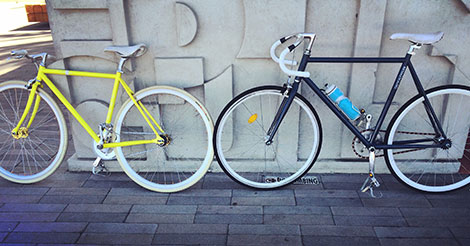Archive Monthly Archives: August 2016

Case Study – Cyclist v Unidentified Vehicle
Cordin v Nominal Defendant
Cordin v Nominal Defendant is a decision out of the District Court of NSW. The Court awarded the Plaintiff cyclist $350,000 in damages for the injuries he sustained after he fell from his bicycle. It was alleged by the Plaintiff cyclist that as he was applying his brakes in the course of coasting to negotiate his way around a series of potholes, a motor vehicle struck his bicycle from behind. He was thrown forward onto the roadway and sustained a head injury, compression fractures to his thoracic spine, injuries to both hands, wrists and knees.
Despite attempts, the Plaintiff cyclist was unable to identify the motor vehicle involved and ultimately proceeded with a claim against a Nominal Defendant.
The Nominal Defendant fervently defended the claim. The basis of their defence was that the Plaintiff cyclist sustained injuries after striking a pothole in the road. They denied the involvement of a motor vehicle.
The key issue of determination by the Court was whether a motor vehicle was in fact involved.
The Plaintiff led evidence from an expert that the damage occasioned to his bicycle and the injuries he sustained would have been occasioned in the circumstances he alleged occurred (that is, being struck from behind by a motor vehicle.)
The Defendant led expert evidence to the contrary. Their evidence was that the injuries would have resulted from striking a pothole.
The evidence from the Plaintiff’s expert was ultimately preferred and the finding was made by the Court that a motor vehicle was involved. The Court held that the driver of that vehicle had been negligent for failing to keep a proper lookout of the roadway ahead (in order to appropriately deal with foreseeable risks) and awarded the Plaintiff cyclist damages in the order of $350,000.00.

Case Study- Cyclist v Cyclist
FRANKLIN V BLICK
Franklin v Blick is a decision out of the Supreme Court of the ACT.
Here, the court awarded the Plaintiff cyclist $1.6 million in damages after another cyclist caused him to fall from his bicycle and be run over by a passing motor vehicle. The two cyclists were travelling home from work together in a dedicated bicycle lane on Capital Circle in Canberra. The defendant cyclist was cycling in front of the plaintiff cyclist and failed to see a piece of wood lying on the ground. He struck the piece of wood and then veered into the plaintiff cyclist. As a consequence, the plaintiff cyclist fell from his bicycle onto the road and was subsequently struck by a passing motor vehicle.
The Plaintiff cyclist suffered a multiplicity of significant injuries including a fractured pelvis, fractured right transverse process, internal bleeding, grazes and bruising. The Plaintiff cyclist worked in IT on a contract basis but unfortunately was unable to return to his pre-injury capacity and has to significantly reduce his working hours. He was also unable to return to competition as a triathlete.
The Court found that the Defendant cyclist was liable on the basis that he breached the duty of care he owed to the Plaintiff. The Court found that the defendant cyclist should’ve been keeping a proper lookout and ought to have seen the piece of wood lying on the ground. Ultimately, it was accepted that the Plaintiff’s injuries flowed directly from the Defendant cyclists negligence.

A Picture Speaks a Thousand Words
We have all seen the footage on YouTube and scattered across social media sites. A motor vehicle travelling in the same direction as a cyclists, sees the cyclist, thinks it can pass (albeit narrowly), and nearly causes a collision. Worse yet, a collision results with injurious outcomes!
Footage has also become a common feature on news websites, with videos featuring regularly of cyclists getting into conflict with motorists – road rage incidents and again often with injurious outcomes.
More often than not, the footage is captured by a GoPro camera (or the like) attached to the cyclist or their bicycle.
So why are cyclists turning to cameras?
Some cyclists report that cameras are becoming an important safety device. They report that motorist behaviour dramatically improves when they are aware they are being recorded, resulting in more awareness and improved safety. It’s not the perfect motivation for doing the right thing, but if fear of being caught deters someone from doing the wrong thing, then it has served a purpose.
Cyclists also report relying on footage captured if there’s an incident or accident on the road. As the old saying goes – a picture speaks a thousand words. Hard evidence can be a good way of helping elicit fairer outcomes. And with a significant percentage of collisions involving cyclists being hit from behind or the side, footage can prove vital in identifying who was involved and what happened.
Ultimately, the increasing use of cameras and like devices will hopefully improve road safety by raising driver consciousness and acting as a deterrent.

5 Road Rules every Cyclist wants Motorists to Understand
- On a multi-lane road, cyclists can take up any position within the lane
On a multi-lane road, cyclists can take up any position within the lane. Every cyclist is different. Every cyclist rides in a different way. Some like to occupy a central position on the lane – and they are entitled to do so.
- Cyclists can overtake another vehicle on the left
Cyclists can overtake another vehicle on the left if it is safe to do so, and unless that vehicle is turning left and indicating they will turn left.
- Cyclists can choose whether or not they wish to use a bicycle lane where one is provided.
Cyclists can choose whether or not to occupy a bicycle line. Again, every cyclist is different. Some cyclists may not choose to occupy the bicycle lane – and they are entitled to make this choice.
- Cyclists can ride on the road shoulder, across a continuous white-edge line on a bicycle.
Cyclists are entitled to rise on the road shoulder; however, they must give way to vehicles on the road when moving back onto the road across the continuous white edge line.
- Cyclists can ride across pedestrian crossings situated at traffic lights if they:
Cyclists can ride across a pedestrian crossing situated at traffic lights if they:-
- Proceed slowly and safely;
- Give way to any pedestrian on the crossing;
- Keep to the left of any oncoming cyclist.

3 Things Cyclists want Motorists to Know
- Cyclists want motorists to understand the road rules.
By gaining a better understanding of the rules regulating cyclists and by following careful practices behind a wheel, motorists will make our roads safer. It is about mutual respect and understanding.
2. Cyclists are closer than they appear
If you are a motorist and are approaching a cyclist on your left, do not try and squeeze past. The bike is closer than it seems. Stop. Slow down. Wait. Whatever it takes. Do not pass until you can leave plenty of room and pass safely.
3. Cyclists are a vulnerable road user.
Most motorists have a strong respect for cyclists and understand their vulnerability on the road. Unfortunately, there is a small minority of road users who do not share the same understanding, and are ignorant of the vulnerability of cyclists on our roads.
It is a pretty safe bet that is a cyclist comes up against a motor vehicle, the cyclist is going to come off second best. Understand this, and respect all road users.
